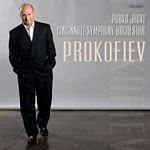After his success with Prokofiev’s Romeo and Juliet (type Q7033 in Search Reviews), Paavo Järvi turns in a disappointing Symphony No. 5. Color is a significant problem here, as much of the score, though handsomely played by the Cincinnati Symphony Orchestra, sounds texturally undifferentiated. The trumpet, a key instrument in this work, too often blends into the orchestral sonority. Listen to how the conductor’s father, Neeme Järvi (Chandos), adds a tart edge by letting the trumpet stand out from the texture. Even Karajan, considered by many to be music’s great homogenizer, offers a more colorful and aurally stimulating orchestral palette.
Paradoxically, Järvi does reveal some unusual instrumental details, such as the piano, which turns out to be a more important element to the sound than is often realized. But while it’s nice to hear the instrument’s low trills in the first-movement coda, that certainly doesn’t make up for the lack of excitement. Again, turn to Neeme Järvi and hear the arresting brass playing, or to Karajan, who offers a shockingly (for him) prominent tam-tam and incredibly massive strings. Muti and Bernstein are equally stirring in this passage.
The Adagio holds similar frustrations: it’s beautifully played, and there’s much inner detail to delight the ear, but Järvi holds back on the emotion enough to make the tortured climax unsatisfying. Telarc’s low-level, flat-perspective recording may be a factor contributing to this impression. Cincinnati’s Symphony Hall rarely has been a flattering venue, but in this case the violins sound distant and echoey, while trumpets and horns sound covered (although the low brass stands out on its own–not a bad thing in Prokofiev). Järvi fares better with the lighthearted scherzo and in the finale, where he captures much of the music’s humor. But I kept getting the sense of performers who feel too casual, too comfortable toward this music. The Lieutenant Kijé suite is far more engaging (it’s hard to imagine a bad performance of this work), but that’s not enough of a reason to choose this recording over the listed alternatives.
































